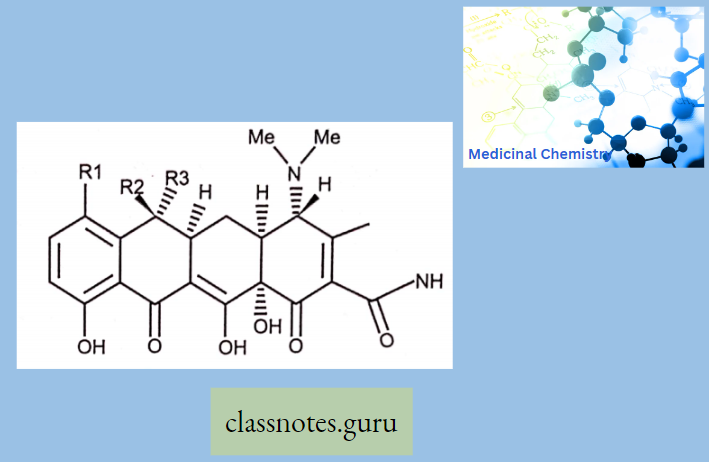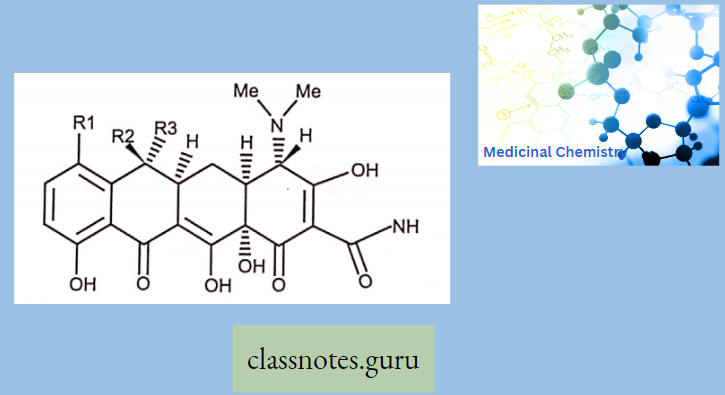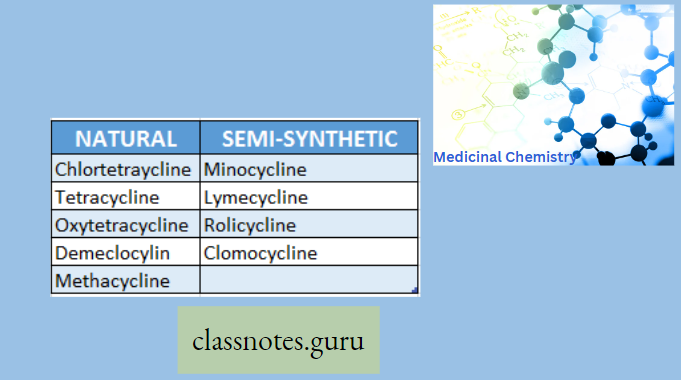Tetracycline Introduction
Tetracyclines are a group of broad-spectrum antibiotic compounds that have a common basic structure and are either isolated directly from several species of Streptomyces bacteria or produced semi-synthetically from those isolated compounds.
Tetracycline molecules comprise a linear fused tetracyclic nucleus (rings designated A, B, C, and D) to which a variety of functional groups are attached
Tetracycline Mode Of Action
The antimicrobial activity of tetracyclines reflects reversible binding to the bacterial 30S ribosomal subunit, specifically at the aminoacyl-tRNA acceptor (“A”) site on the mRNA ribosomal complex, thus preventing ribosomal translation Adverse Effect discoloration of teeth, kidney damage (Fanconi syndrome)
Read and Learn More Medicinal Chemistry III Notes
Chemistry Of Tetracycline
Carbon atom 4,4a, 5, 5a, 6 and 12a are potentially chiral.
- Oxytetracycline and doxycycline each with 5-OH substituents have six asymmetric centers while others have only five.
- The basic ring present in Tetracycline is polycyclic naphthalene carboxamide.
- All Tetracycline is amphoteric.
- At pH-7, it is converted into Zwitter-ion.

Ability to undergo epimerization at C4 in a solution of neutral pH range

Tetracycline Classification



Tetracycline Contraindication
Tetracycline forms a chelate complex with many metals like calcium, magnesium, and iron.
- Chelates are usually insoluble in water which impairs the absorption of tetracycline in the presence of milk, Ca, Mg, and A α-containing antacids.
- The affinity of tetracycline for calcium causes them to be incorporated into newly forming bones and teeth as a tetracycline-calcium orthophosphate complex.
- Deposition of these antibiotics in teeth causes yellow discoloration.
- In pregnancy, Tetracycline is distributed into the milk of the lactating mother and it crosses the placental barrier into the fetus hurting the bones and teeth of a child.
Sar Of Tetracycline
Tetracyclines are composed of a rigid skeleton of 4 fused rings. The ring structure of tetracyclines is divided into an upper modifiable region and a lower non-modifiable region.
- An active tetracycline requires a C10 phenol as well as a C11-C12 keto-enol substructure in conjugation with an OH group and a C1-C3 diketo substructure. Removal of the dimethylamine group at C4 reduces antibacterial activity.
- Replacement of the carboxylamine group at C2 results in reduced antibacterial activity but it is possible to add substituents to the amide nitrogen to get more soluble analogs like the prodrug lymecycline.
- The simplest tetracycline with measurable antibacterial activity is 6-deoxy 6- demethyltetracycline and its structure is often considered to be the minimum pharmacophore for the tetracycle class of antibiotics can be modified to make derivatives with varying antibacterial activity
Tetracycline Multiple Choice Question And Answers
Question 1. The adverse effect of tetracycline is…
- Gray baby syndrome
- Fanconi syndrome
- Ototoxicity
Red Man syndrome
Answer: 2. Fanconi syndrome
Question 2. Tetracycline act on…
- 50s position
- 30s position
- Both
- None
Answer: 2. 30s position
Question 3. Epimerization in tetracycline takes place at…
- 3 position
- 4 position
- 5 position
- 6 position
Answer: 2. 4 position
Question 4. Yellow discoloration of teeth is caused by …
- Chloramphenicol
- Amino glycoside
- Tetracycline
- Macrolide
Answer: 3. Tetracycline
Question 5. Photo Toxicity is the adverse effect of…
- Chlortetracycline
- Rolitetracycline
- Demeclocycline
- Doxycycline
Answer: 3. Demeclocycline
Tetracycline Short Question And Answers
Question 1. Classify natural tetracycline.
Answer:
Natural Tetracycline: Chlortetracycline, Tetracycline, Oxytetracycline, Demeclocylin
Question 2. Write the name of the semi-synthetic tetracycline.
Answer:
The Name Of The Semi-Synthetic Tetracycline: Minocycline, Lymecycline, Rolicycline, Clomocycline, Methacycline
Question 3. What is the mode of action of tetracycline?
Answer:
The Mode Of Action Of Tetracycline: The antimicrobial activity of tetracyclines reflects reversible binding to the bacterial 30s ribosomal subunit, specifically at the aminoacyl-tRNA acceptor (“A”) site on the mRNA ribosomal complex, thus preventing ribosomal translation.
Question 4. What position is responsible for epimerization in tetracycline?
Answer:
C4 position.
Question 5. What is zwitter ion?
Answer:
Zwitter Ion: The compounds contain both charges in their structure.
